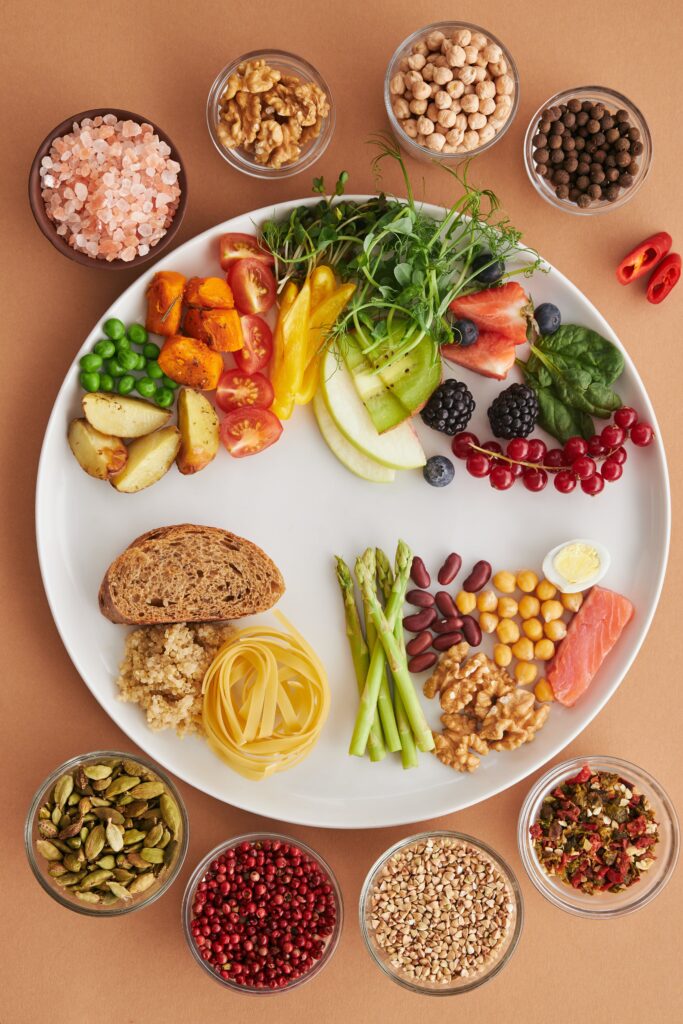
Transforming your eating habits is a journey that requires commitment and practical tips that fit into your lifestyle. Whether you’re looking to lose weight, improve your health, or simply feel better, healthy eating habits are the foundation of a well-rounded lifestyle. In this article, we’ll explore some practical tips that can help you plan meals effectively, choose healthy snacks, and avoid dietary pitfalls that can derail your progress.
Understanding healthy eating is the first step towards transforming your eating habits. It’s important to know what foods are good for you and how to incorporate them into your diet. We’ll cover meal planning strategies that can help you stay on track with your goals, as well as healthy snacking options that can keep you satisfied between meals. We’ll also explore how to navigate dietary pitfalls, such as emotional eating and food cravings, so that you can stay focused on your goals.
Key Takeaways
- Understanding healthy eating is the first step towards transforming your eating habits.
- Meal planning strategies and healthy snacking options can help you stay on track with your goals.
- Navigating dietary pitfalls is key to maintaining healthy eating habits.
Understanding Healthy Eating

Healthy eating is not about strict limitations or depriving yourself of the foods you love. Rather, it is about making informed choices and adopting healthy eating habits that can be sustained over time. In this section, we will explore the basics of healthy eating, including macronutrients, micronutrients, and how to balance them effectively.
Nutritional Basics
Nutrition is the study of how food affects the body and the processes by which the body uses food for growth, maintenance, and repair. The three macronutrients that provide calories are carbohydrates, proteins, and fats. Carbohydrates are the body’s primary source of energy, while proteins are essential for building and repairing tissues. Fats are important for energy storage, insulation, and cushioning of vital organs.
Balancing Macronutrients
Achieving a balanced intake of macronutrients is key to maintaining good health. A balanced diet should include a variety of foods from all food groups, including fruits, vegetables, whole grains, lean proteins, and healthy fats. It is important to note that not all fats are created equal. Saturated and trans fats should be limited, while unsaturated fats, such as those found in nuts, seeds, and fatty fish, can be beneficial for heart health.
Importance of Micronutrients
Micronutrients, such as vitamins and minerals, are essential for maintaining good health and preventing chronic diseases. They play important roles in various bodily functions, including immune function, energy production, and bone health. Eating a variety of fruits, vegetables, whole grains, lean proteins, and healthy fats can help ensure that you are getting all the micronutrients your body needs.
By understanding the basics of healthy eating, you can make informed choices and adopt healthy eating habits that fit into your lifestyle. In the next section, we will explore how to plan meals effectively and choose healthy snacks to help you achieve your health goals.
Meal Planning Strategies

Planning your meals in advance is an effective way to ensure that you consume a balanced and healthy diet. Here are some tips to help you create a meal plan that works for you:
Creating a Balanced Meal Plan
When planning your meals, aim for a balanced diet that includes a variety of nutrient-dense foods. A balanced meal should include a source of lean protein, complex carbohydrates, healthy fats, and fiber-rich fruits and vegetables.
To make things easier, consider using a meal planning template or app to help you organize your meals for the week. You can also plan your meals around your schedule, so that you have quick and easy meals for busy days and more elaborate meals for days when you have more time.
Prepping Meals in Advance
Meal prepping is a great way to save time and ensure that you have healthy meals ready to go. Consider preparing your meals in advance by cooking large batches of food and storing them in the fridge or freezer.
You can also prep ingredients in advance, such as chopping vegetables or marinating meat, to make meal prep easier and faster. This will help you save time during the week and ensure that you have healthy meals on hand when you need them.
Shopping for Healthy Ingredients
When shopping for healthy ingredients, focus on whole foods such as fruits, vegetables, whole grains, lean proteins, and healthy fats. Avoid processed foods and snacks that are high in added sugars, sodium, and unhealthy fats.
To make shopping easier, consider making a grocery list and sticking to it. This will help you avoid impulse purchases and ensure that you have all the ingredients you need for your meals. You can also save time by shopping online or using a grocery delivery service.
By following these meal planning strategies, you can transform your eating habits and achieve your health and wellness goals.
Healthy Snacking Options

Snacking can be a healthy part of your diet, as long as you choose the right foods and practice portion control. Here are some tips to help you snack smarter:
Choosing Nutrient-Dense Snacks
When it comes to snacking, it’s important to choose foods that are nutrient-dense. This means they are high in nutrients like vitamins, minerals, and fiber, but relatively low in calories. Some examples of nutrient-dense snacks include:
- Fresh fruit, such as apples, bananas, and berries
- Raw vegetables, such as carrots, celery, and bell peppers
- Nuts and seeds, such as almonds, walnuts, and pumpkin seeds
- Low-fat dairy products, such as Greek yogurt and cottage cheese
- Whole-grain crackers or rice cakes with hummus or nut butter
By choosing nutrient-dense snacks, you can satisfy your hunger and get the nutrients your body needs without consuming too many calories.
Portion Control Tips
Even healthy snacks can add up in calories if you eat too much of them. To practice portion control, try these tips:
- Use small plates or bowls to help you keep your portions in check
- Measure out your snacks in advance to avoid overeating
- Avoid eating straight out of the bag or container, as this can make it harder to control your portions
- Take your time and savor your snacks, rather than eating them quickly
By paying attention to your portions, you can enjoy your snacks without sabotaging your healthy eating goals.
Snack Preparation Techniques

Preparing your snacks in advance can help you make healthier choices and avoid reaching for less healthy options when you’re hungry. Try these snack preparation techniques:
- Cut up fresh fruits and vegetables and store them in the fridge for easy snacking
- Make your own trail mix with nuts, seeds, and dried fruit
- Pre-portion snacks like nuts or whole-grain crackers into small bags or containers for easy grab-and-go options
- Make your own healthy dips, like hummus or guacamole, to pair with fresh veggies or whole-grain crackers
By preparing your snacks in advance, you can make healthier choices and avoid reaching for less healthy options when you’re hungry.
Navigating Dietary Pitfalls
When it comes to healthy eating, avoiding dietary pitfalls is crucial. These pitfalls can derail your progress and make it difficult to maintain a healthy diet. In this section, we will discuss some common dietary pitfalls and how to avoid them.
Identifying Unhealthy Food Triggers
Food triggers are certain foods or situations that cause you to overeat or make unhealthy food choices. Identifying these triggers is the first step in avoiding them. Some common food triggers include stress, boredom, and social situations. To identify your food triggers, keep a food diary and note how you feel before and after eating.
Avoiding Processed Foods
Processed foods are often high in calories, sugar, and unhealthy fats. They can also be addictive, making it difficult to stop eating them once you start. To avoid processed foods, focus on whole, unprocessed foods such as fruits, vegetables, lean proteins, and whole grains. When shopping, read food labels carefully and avoid products with added sugars, trans fats, and other unhealthy ingredients.
Dining Out Mindfully
Eating out can be a challenge when trying to maintain a healthy diet. Restaurant meals are often high in calories, fat, and sodium. To dine out mindfully, choose restaurants that offer healthy options, such as salads, grilled fish, and steamed vegetables. When ordering, ask for dressings and sauces on the side, and avoid fried foods and creamy sauces. You can also split a meal with a friend or take half of your meal home for later.
By identifying unhealthy food triggers, avoiding processed foods, and dining out mindfully, you can navigate dietary pitfalls and maintain a healthy diet. With these practical tips, you can transform your eating habits and achieve your health goals.
Incorporating Healthy Habits

When it comes to healthy eating, incorporating healthy habits into your daily routine can make a significant difference. Here are some practical tips that can help you transform your eating habits:
Staying Hydrated
Drinking enough water is essential for maintaining good health. According to the CDC, water helps regulate body temperature, transport nutrients, and remove waste from the body. It is recommended to drink at least eight glasses of water per day. You can also incorporate other hydrating beverages such as herbal tea, coconut water, or fresh fruit juice.
Regular Physical Activity
Regular physical activity is essential for maintaining a healthy weight and reducing the risk of chronic diseases such as heart disease, diabetes, and certain cancers. According to the American Heart Association, adults should aim for at least 150 minutes of moderate-intensity aerobic activity or 75 minutes of vigorous-intensity aerobic activity per week. Additionally, strength training exercises should be done at least twice a week.
Adequate Sleep and Recovery
Getting enough sleep is crucial for overall health and well-being. According to the National Sleep Foundation, adults should aim for seven to nine hours of sleep per night. Getting enough sleep can help improve mood, memory, and concentration, as well as reduce the risk of obesity, diabetes, and heart disease. Additionally, taking rest days and allowing your body to recover after exercise is essential for preventing injury and improving performance.
Frequently Asked Questions

How can I start eating healthier as a beginner?
If you’re new to healthy eating, it can be overwhelming to know where to start. The key is to make small changes gradually. Start by adding more vegetables and fruits to your diet, and reduce your intake of processed and sugary foods. Try to cook more meals at home and experiment with new recipes. It’s also important to stay hydrated by drinking plenty of water throughout the day.
What are the top 10 foods I should include in a healthy diet?
There are many nutritious foods that you can include in your diet, but here are some of the top choices:
- Leafy greens like spinach and kale
- Berries like blueberries and strawberries
- Whole grains like quinoa and brown rice
- Nuts and seeds like almonds and chia seeds
- Lean proteins like chicken and fish
- Legumes like lentils and chickpeas
- Low-fat dairy products like yogurt and cheese
- Healthy fats like avocado and olive oil
- Colorful vegetables like bell peppers and carrots
- Herbs and spices like garlic and turmeric
What strategies can I use to maintain healthy eating habits daily?
One of the best ways to maintain healthy eating habits is to plan ahead. Take some time each week to plan your meals and snacks, and make a grocery list. This can help you avoid making impulsive food choices when you’re hungry. It’s also important to listen to your body and eat when you’re hungry, but stop when you’re full. Finally, try to make healthy eating a habit by incorporating it into your daily routine.
How can meal planning contribute to a healthier lifestyle?
Meal planning can make healthy eating easier and more convenient. By planning your meals in advance, you can ensure that you have nutritious options available when hunger strikes. It can also help you save time and money by reducing the need to eat out or order takeout. Additionally, meal planning can help you avoid unhealthy food choices by giving you a clear plan for what to eat.
What are the benefits of adopting healthy eating practices?
Adopting healthy eating practices can have many benefits for your overall health and well-being. Eating a nutritious diet can help you maintain a healthy weight, reduce your risk of chronic diseases like heart disease and diabetes, improve your mood and energy levels, and even boost your immune system.
How can I avoid common dietary pitfalls when trying to eat healthily?
One common dietary pitfall is relying too heavily on processed and convenience foods. These foods are often high in calories, unhealthy fats, and added sugars. Another pitfall is skipping meals or snacks, which can lead to overeating later on. Finally, it’s important to be mindful of portion sizes and avoid overeating, even when you’re eating healthy foods.
